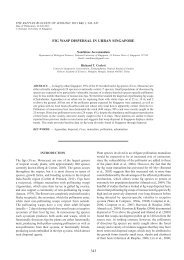1O257LF
1O257LF
1O257LF
Create successful ePaper yourself
Turn your PDF publications into a flip-book with our unique Google optimized e-Paper software.
© 2010 Dinosauria International Ten Sleep Report Series No. 1<br />
in part Senter’s (2007) discussion of neck elongation in<br />
sauropods, which may have been driven by sexual selection,<br />
and not by feeding competition. The height, bifurcation of<br />
neural spines, and ventral width of centra between males<br />
and females is another sexual dimorphic feature seen in the<br />
cervical vertebrae. The narrower width of the neural spines<br />
on the cervical vertebrae in DQ-SB, DQ-BS, and DQ-TY are<br />
quite slender in comparison to DQ-PE. In other words, the<br />
width of the cervical across the ribs in Prince allows it to<br />
fit over the slender female necks. Moreover, a broadened<br />
neck may also have played a role in courtship display and<br />
in male rivalry. The courtship displays may have had a<br />
cobra-like effect in their swaying heads and necks helping<br />
to appear much larger. Intraspecific combat, territorial<br />
defense, and dominance could have been achieved among<br />
males by pushing or slamming with their necks, in the<br />
same way male giraffes compete with each other using their<br />
necks and heads. The small size or absence of pleurocoel<br />
fossae in much of the vertebrae, particularly in the anterior<br />
caudals, may be a developmental male response to acquire<br />
the necessary weight needed for dominance in rivalry “push<br />
off’ battles for example. Many of the features regarded as<br />
gender specific can also be seen in young individuals. It is<br />
possible that the extreme morphological features observed<br />
in males are retained neotenic traits. For example, the long<br />
cervical ribs, short axial skeleton, and absent pleurocoels<br />
are neotenic traits that can be seen in SMA 0009 from Howe<br />
Quarry. All these features also recall the male characteristics<br />
we see in the Dana sample.<br />
Morrison diplodocids may have occupied a<br />
proboscidean-like niche with a gregarious population of<br />
males and females analogous to African elephant herds.<br />
We speculate that Apatosaurus males with larger and more<br />
massive bodies would have powerful broad necks for<br />
courtship displays and subduing females. African elephants<br />
vary greatly, but males are generally much more massive than<br />
same age adult females. In addition to overall greater size and<br />
stature, male elephants may be twice the weight of females.<br />
Principle courtship display in male elephants is their larger<br />
tusks. Amphicoelias females may have formed herds to help<br />
rear calves, which were led by a dominating harem keeping<br />
male. Males may have lived a solitary existence away from<br />
the herd appearing only during courtship. This may explain<br />
why, in the best fossil sites, Amphicoelias/Diplodocus is found<br />
in multiples while Apatosaurus, only as occasional isolated<br />
occurrences. One notable exception is in Dinosaur National<br />
Monument where three Apatosaurus specimens have been<br />
reported, but these individuals may have been washed in<br />
from further upstream.<br />
The morphological distances and occurrence<br />
between Camarasaurus and Brachiosaurus are similar in many<br />
ways to what exists in the Dana sample, thus the possible<br />
need to reconsider them as possible gender based taxa.<br />
Ontogeny<br />
Great morphological variation exists in one<br />
documented Saurischian population, the mass mortality<br />
collection of Coelophysis, from Ghost Ranch New Mexico<br />
(Colbert 1989). Colbert (1989) reports on the proportions<br />
of limb to cervical lengths, in Coelophysis, which can vary<br />
greatly, as much as 20% or more, demonstrating that axial<br />
vs. appendicular development is not equally synchronized.<br />
As exemplified in two immature specimens, DQ-TY and<br />
SMA 0009, the same ontogenetic condition appears to exist<br />
in both Amphicoelias and Coelophysis. The recognition of<br />
ontogenetic features is of great taxonomic importance not<br />
only for diplodocids but other sauropods. In addition to<br />
sexual dimorphism and individual variation, ontogeny helps<br />
to indentify character polarity in a clear biological manner.<br />
Fig 32 Comparison of illia belonging to DQ-TY and SMA<br />
0009 illustrating the elongated pubic peduncle in juveniles of<br />
Amphicoelias. Bottom row: adult Apatosaurus and Diplodocus illia for<br />
comparison. See also Fig 7C, DQ-SB. (Illustrations: Schwarz 2007,<br />
Hatcher 1903)<br />
44<br />
The baby sauropod skeleton “Toni”, described by<br />
Schwarz, et al (2007) (SMA 0009, Howe Stephens Quarry,<br />
Shell, Wyoming), belongs in the genus Amphicoelias and<br />
probably represents A. “brontodiplodocus”. Toni’s clavicle is<br />
the same boomerang-like shape as in DQ-SB and DQ-TY.<br />
Compared with the fragment described by Harris (2007)<br />
as a possible clavicle belonging to Suuwassea, the Dana<br />
Quarry clavicles are more bent and without rugosities on



